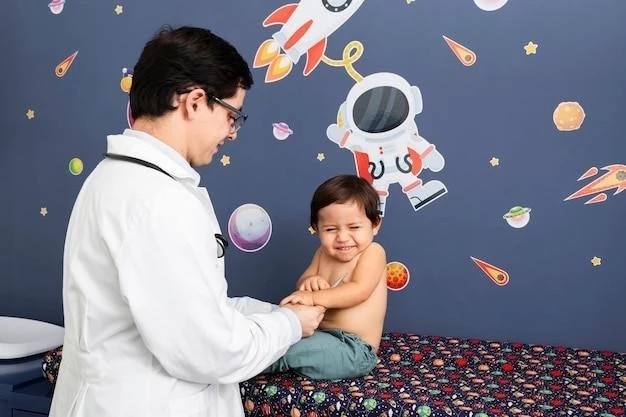Disease ⎼ KID Syndrome
KID Syndrome, a rare genetic disorder, presents with a combination of keratitis, ichthyosis, and deafness. This article will provide an overview of the pathology, clinical features, diagnosis, treatment, prognosis, and recent research advances related to this syndrome.
Introduction to KID Syndrome
KID Syndrome is a rare genetic disorder with a triad of symptoms, namely keratitis, ichthyosis, and deafness. It falls under the category of ectodermal dysplasias, impacting structures derived from the ectodermal layer during embryogenesis. The connexin gene family, specifically GJB2 encoding connexin 26٫ is often implicated in KID Syndrome. This mutation affects the function of gap junctions٫ which play a crucial role in cell-to-cell communication. The resulting abnormalities lead to the characteristic symptoms associated with the syndrome. Individuals with KID Syndrome typically present with various skin abnormalities such as ichthyosis٫ ocular abnormalities like keratitis٫ sensorineural hearing loss٫ and developmental delay. Due to the multisystem nature of the condition٫ a multidisciplinary approach involving dermatologists٫ ophthalmologists٫ audiologists٫ and developmental specialists is essential for the comprehensive management of patients with KID Syndrome. Understanding the underlying genetic and molecular mechanisms of the syndrome is crucial for developing targeted therapies and improving patient outcomes.

Understanding the Pathology
The pathology of KID Syndrome is primarily linked to mutations in the GJB2 gene٫ leading to abnormal functioning of connexin 26. Connexin proteins are crucial for the formation of gap junctions٫ which facilitate intercellular communication. In individuals with KID Syndrome٫ the defective connexin 26 disrupts the normal cell signaling processes٫ resulting in various manifestations of the syndrome. The skin abnormalities observed in KID Syndrome٫ such as ichthyosis٫ are attributed to the impaired communication between skin cells. Similarly٫ the development of keratitis٫ characterized by inflammation of the cornea٫ is influenced by the disrupted gap junction communication in the corneal cells. The sensorineural hearing loss seen in KID Syndrome is a consequence of malfunctioning connexin 26 in the cochlea٫ affecting auditory signal transmission. Additionally٫ the developmental delay found in some individuals with KID Syndrome may be linked to the impact of connexin 26 mutations on neural cell communication during brain development. Understanding the pathology at the molecular level is crucial for targeted treatment strategies aimed at addressing the underlying cellular communication deficits that contribute to the diverse clinical features of KID Syndrome.
Clinical Features of KID Syndrome
KID Syndrome is characterized by a spectrum of clinical features encompassing skin abnormalities, ocular abnormalities, hearing loss, and developmental delay. The skin manifestations often include ichthyosis, a condition marked by dry, scaly skin that may affect the entire body. Ocular abnormalities such as keratitis, inflammation of the cornea, can lead to vision impairment if not managed appropriately. Sensorineural hearing loss, a common feature of KID Syndrome, may vary in severity and typically requires early intervention with hearing aids or cochlear implants. Developmental delay, including speech and motor delays, is observed in some individuals with KID Syndrome and necessitates tailored educational and therapeutic interventions. The combination of these clinical features poses complex challenges in the management of individuals with KID Syndrome, requiring a multidisciplinary approach involving dermatologists, ophthalmologists, audiologists, developmental specialists, and other healthcare professionals. Early recognition and comprehensive evaluation of the clinical features are essential for initiating timely interventions to optimize the quality of life for individuals affected by KID Syndrome.
Diagnosis and Differential Diagnosis
Diagnosing KID Syndrome involves a combination of clinical evaluation, genetic testing, and imaging studies. The presence of the characteristic triad of symptoms – keratitis, ichthyosis, and deafness – raises suspicion for KID Syndrome. Dermatological examination may reveal the typical skin abnormalities associated with ichthyosis. Ophthalmologic assessment is crucial to identify signs of keratitis, while audiometry is performed to evaluate hearing function. Genetic testing, particularly for mutations in the GJB2 gene encoding connexin 26, can confirm the diagnosis of KID Syndrome. Differential diagnosis may include other ectodermal dysplasias and syndromes with overlapping clinical features such as Netherton syndrome and Harlequin ichthyosis. Distinguishing KID Syndrome from these conditions is essential to guide appropriate management strategies and genetic counseling. Multidisciplinary collaboration among dermatologists, ophthalmologists, geneticists, and audiologists is paramount in achieving an accurate diagnosis and developing a comprehensive care plan for individuals with suspected KID Syndrome.
Treatment and Management
The treatment and management of KID Syndrome aim to address the multisystem manifestations of the disorder and improve the quality of life for affected individuals. Management of skin abnormalities like ichthyosis involves emollients, keratolytics, and topical medications to alleviate dryness and scaling. Ocular care for keratitis includes lubricating eye drops, anti-inflammatory agents, and protective measures to preserve corneal integrity and visual function. Individuals with sensorineural hearing loss may benefit from hearing aids, cochlear implants, or auditory rehabilitation programs to enhance communication abilities. Developmental delays require early intervention with personalized therapies, educational support, and behavioral interventions. Genetic counseling is essential for individuals and families affected by KID Syndrome to understand the hereditary nature of the disorder and make informed decisions regarding family planning. Regular follow-up visits with a multidisciplinary team of healthcare providers are crucial to monitor disease progression, adjust treatment strategies, and address emerging medical, developmental, and psychosocial needs. Collaborative care involving dermatologists, ophthalmologists, audiologists, geneticists, speech therapists, and educators is vital for the comprehensive and holistic management of individuals with KID Syndrome.
Prognosis and Research Advances
The prognosis of individuals with KID Syndrome varies depending on the severity of symptoms, timing of diagnosis, and access to appropriate treatments. Early recognition and intervention can significantly improve outcomes and quality of life for affected individuals. However, the multisystem nature of the disorder and potential complications such as vision and hearing impairments underscore the importance of long-term monitoring and multidisciplinary care. Research in KID Syndrome is advancing our understanding of the underlying genetic mechanisms, cellular communication pathways, and potential targeted therapies. Ongoing studies focus on identifying novel treatment modalities to address specific symptoms associated with the syndrome, including advancements in gene therapy and pharmacological interventions targeting connexin channels. Collaborative efforts among researchers, healthcare professionals, and advocacy groups play a critical role in advancing knowledge, developing innovative therapeutic strategies, and ultimately improving the prognosis for individuals with KID Syndrome. Continued research endeavors hold promise for enhancing diagnostic techniques, refining treatment approaches, and ultimately enhancing the overall prognosis and quality of life for individuals affected by this rare genetic disorder.
